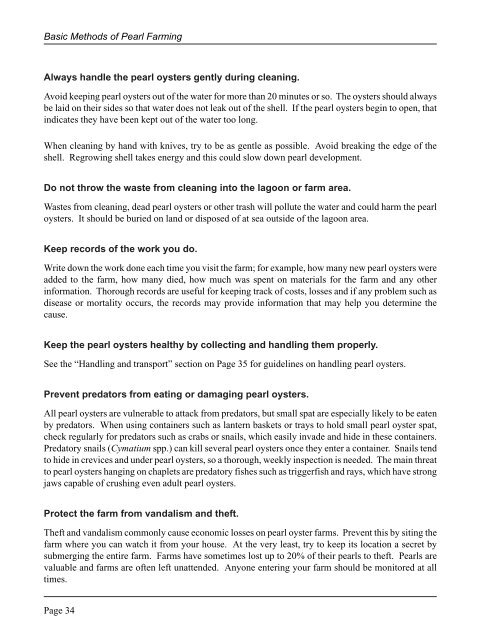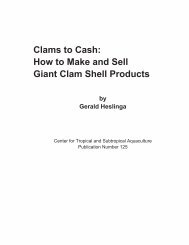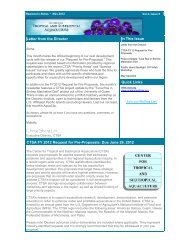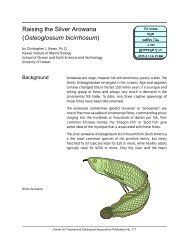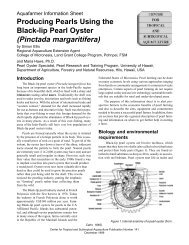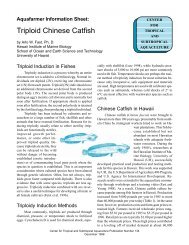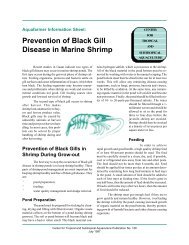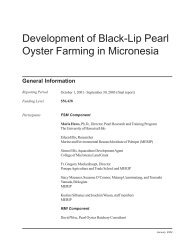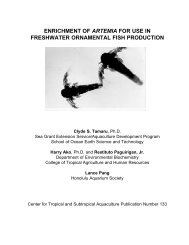The Basic Methods of Pearl Farming: A Layman's Manual - CTSA
The Basic Methods of Pearl Farming: A Layman's Manual - CTSA
The Basic Methods of Pearl Farming: A Layman's Manual - CTSA
Create successful ePaper yourself
Turn your PDF publications into a flip-book with our unique Google optimized e-Paper software.
<strong>Basic</strong> <strong>Methods</strong> <strong>of</strong> <strong>Pearl</strong> <strong>Farming</strong>Always handle the pearl oysters gently during cleaning.Avoid keeping pearl oysters out <strong>of</strong> the water for more than 20 minutes or so. <strong>The</strong> oysters should alwaysbe laid on their sides so that water does not leak out <strong>of</strong> the shell. If the pearl oysters begin to open, thatindicates they have been kept out <strong>of</strong> the water too long.When cleaning by hand with knives, try to be as gentle as possible. Avoid breaking the edge <strong>of</strong> theshell. Regrowing shell takes energy and this could slow down pearl development.Do not throw the waste from cleaning into the lagoon or farm area.Wastes from cleaning, dead pearl oysters or other trash will pollute the water and could harm the pearloysters. It should be buried on land or disposed <strong>of</strong> at sea outside <strong>of</strong> the lagoon area.Keep records <strong>of</strong> the work you do.Write down the work done each time you visit the farm; for example, how many new pearl oysters wereadded to the farm, how many died, how much was spent on materials for the farm and any otherinformation. Thorough records are useful for keeping track <strong>of</strong> costs, losses and if any problem such asdisease or mortality occurs, the records may provide information that may help you determine thecause.Keep the pearl oysters healthy by collecting and handling them properly.See the “Handling and transport” section on Page 35 for guidelines on handling pearl oysters.Prevent predators from eating or damaging pearl oysters.All pearl oysters are vulnerable to attack from predators, but small spat are especially likely to be eatenby predators. When using containers such as lantern baskets or trays to hold small pearl oyster spat,check regularly for predators such as crabs or snails, which easily invade and hide in these containers.Predatory snails (Cymatium spp.) can kill several pearl oysters once they enter a container. Snails tendto hide in crevices and under pearl oysters, so a thorough, weekly inspection is needed. <strong>The</strong> main threatto pearl oysters hanging on chaplets are predatory fishes such as triggerfish and rays, which have strongjaws capable <strong>of</strong> crushing even adult pearl oysters.Protect the farm from vandalism and theft.<strong>The</strong>ft and vandalism commonly cause economic losses on pearl oyster farms. Prevent this by siting thefarm where you can watch it from your house. At the very least, try to keep its location a secret bysubmerging the entire farm. Farms have sometimes lost up to 20% <strong>of</strong> their pearls to theft. <strong>Pearl</strong>s arevaluable and farms are <strong>of</strong>ten left unattended. Anyone entering your farm should be monitored at alltimes.Page 34


